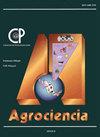EFFECT OF DIFFERENT SPATIAL ARRANGEMENTS OF Jatropha curcas L. ON FOOD CROPS
IF 0.5
4区 农林科学
Q4 AGRICULTURE, MULTIDISCIPLINARY
引用次数: 0
Abstract
The objective of this study was to assess, during three years, the spatial arrangement that will enhance the morpho-productive development of Jatropha curcas L. in association systems with staple crops. It was hypothesized that the association of crops is a factor that determines the behavior of the species and the development of agroenergetic farms, considering rainy and low rainfall periods. A quasi-experimental design was used, and four treatments were tested: 1) J. curcas (Jc) in monoculture; 2) 50 % of the area with Jc and 50 % planted with food crops in rotation (CA); 3) Jc intercropped with CA; and 4) area planted with CA. A principal component statistical analysis was performed with the variables fruit yield and associated crop yield using 95 % confidence intervals from a Student’s t-test. The number of bunches and total fruit and seeds harvested from Jc were shown to be the most important and had a positive correlation for the first component in each period. As for fruit yield, the highest values were achieved in monoculture. Although high yields were not attained in CA, the relationship is regarded favorable since the use of polycultures is viable, fundamentally in the arrangement of 50 % Jc + 50 % CA, being positive the biological efficiency given by the diversification and the best equivalent land use.麻疯树不同空间布局对粮食作物的影响
本研究的目的是在三年时间里,评估在与主食作物的联合系统中,能促进麻疯树形态生产发展的空间布局。根据假设,考虑到多雨和少雨时期,作物的联合是决定物种行为和农业能源农场发展的一个因素。研究采用了准实验设计,测试了四种处理方法:1)单一种植卷柏(Jc);2)50% 的面积种植卷柏,50% 的面积轮作种植粮食作物(CA);3)卷柏与粮食作物间作;4)种植粮食作物的面积。对果实产量和相关作物产量变量进行了主成分统计分析,通过学生 t 检验得出 95% 的置信区间。结果表明,从 Jc 中收获的果穗数、果实和种子总数最为重要,并且与每个时期的第一个分量呈正相关。在果实产量方面,单一栽培的果实产量最高。虽然 CA 的产量不高,但两者之间的关系被认为是有利的,因为从根本上说,在 50 % Jc + 50 % CA 的安排下,使用多栽培技术是可行的,因为多样化和最佳等效土地利用所带来的生物效率是积极的。
本文章由计算机程序翻译,如有差异,请以英文原文为准。
求助全文
约1分钟内获得全文
求助全文
来源期刊

Agrociencia
农林科学-农业综合
CiteScore
0.50
自引率
33.30%
发文量
51
审稿时长
18-36 weeks
期刊介绍:
AGROCIENCIA is a scientific journal created and sponsored by the Colegio de Postgraduados. Its main objective is the publication and diffusion of agricultural, animal and forestry sciences research results from mexican and foreign scientists. All contributions are peer reviewed. Starting in the year 2000, AGROCIENCIA became a bimonthly and fully bilingual journal (Spanish and English versions in the same issue). Since 2007 appears every month and a half (eight issues per year). In addition to the printed issues, the full content is available in electronic format.
 求助内容:
求助内容: 应助结果提醒方式:
应助结果提醒方式:


